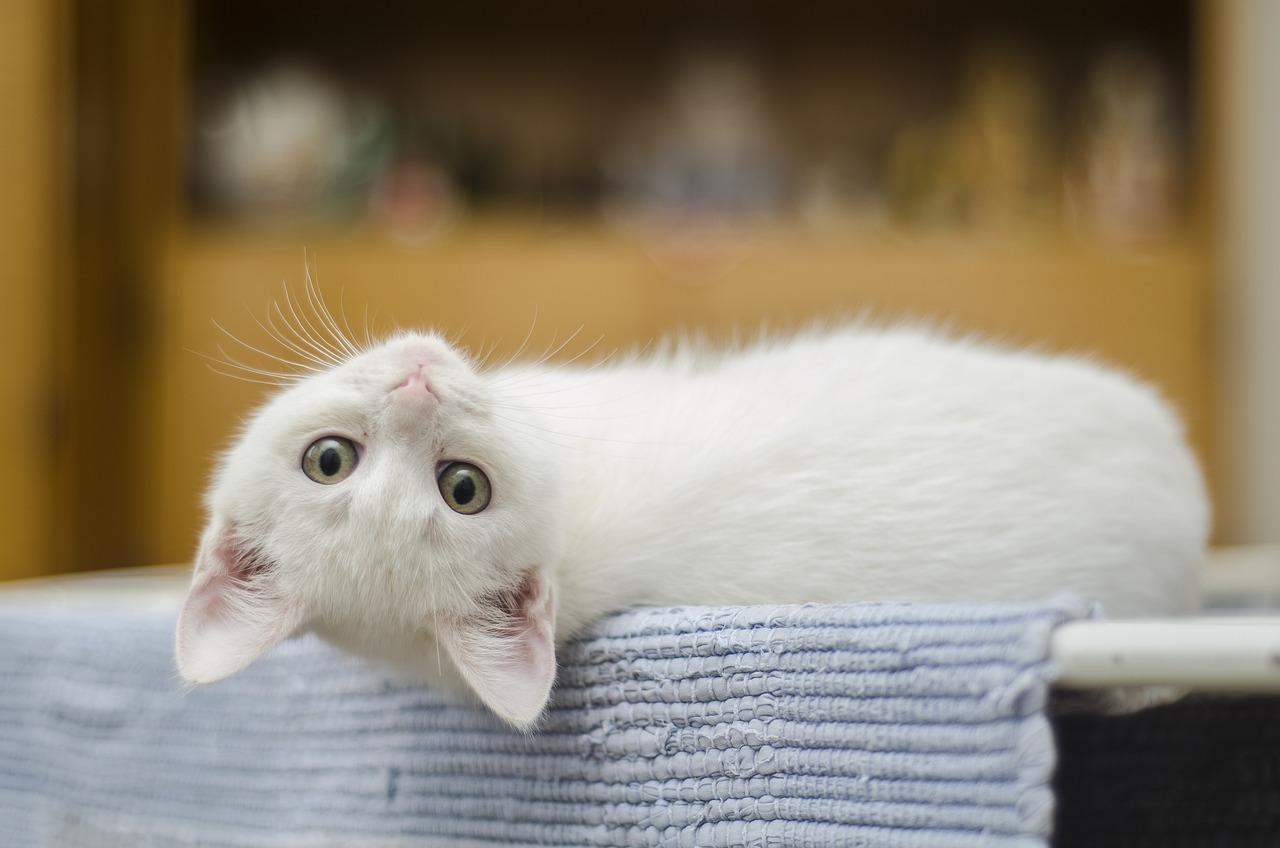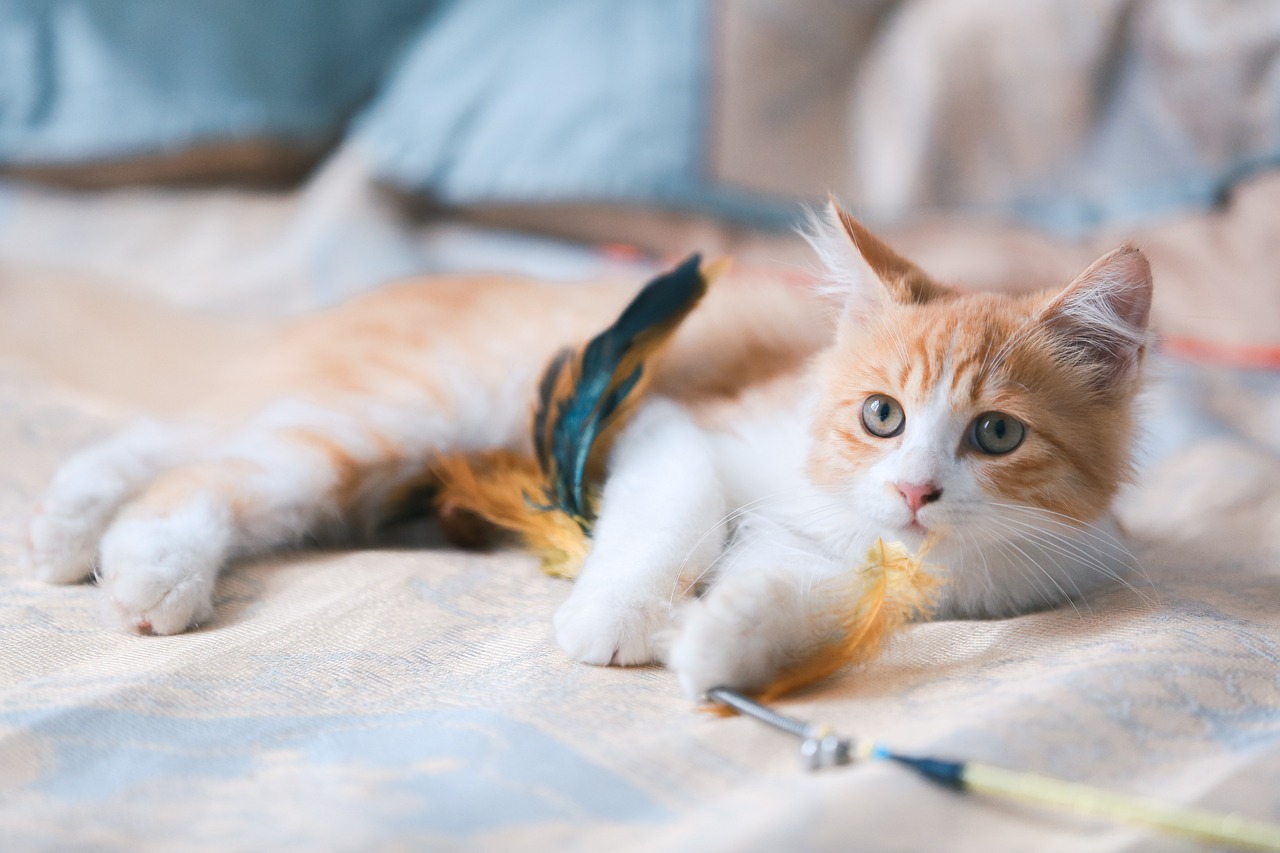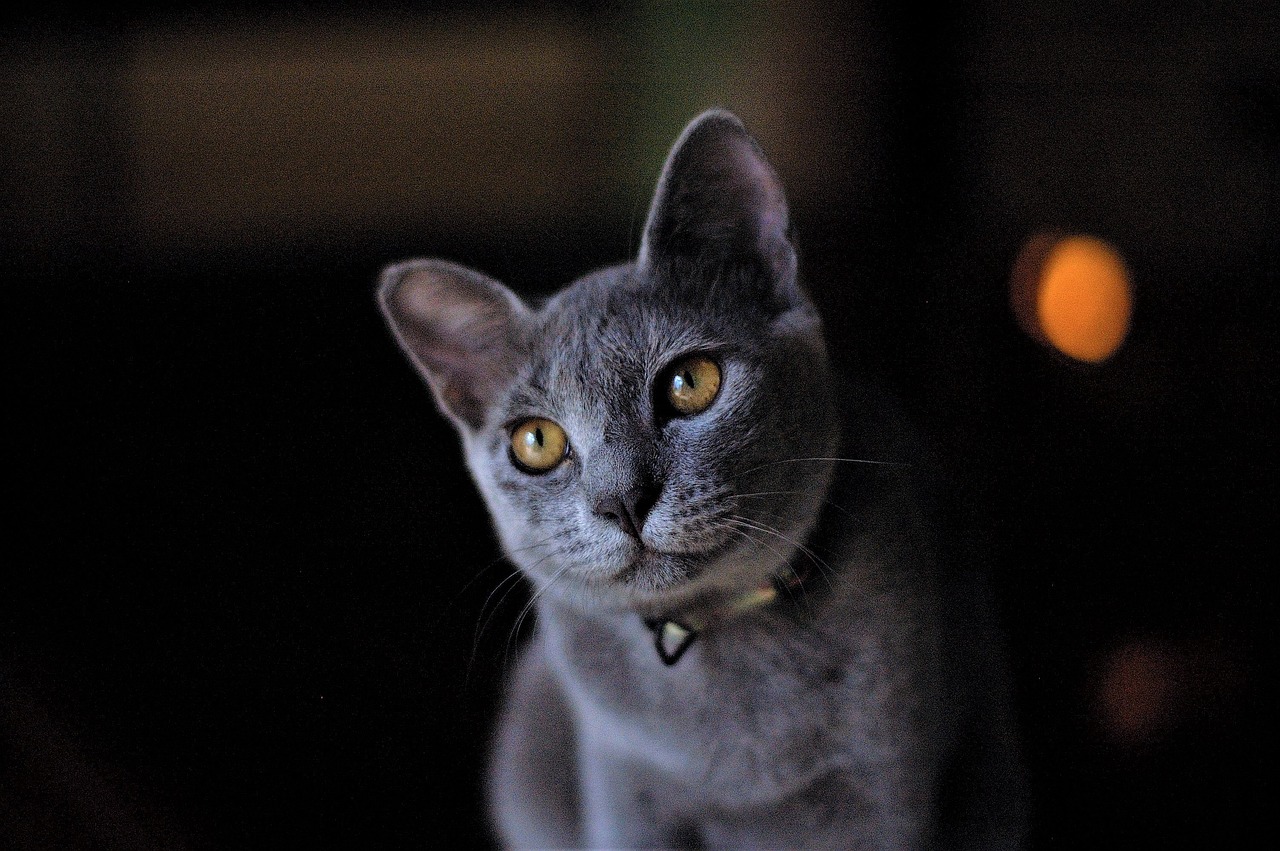Tips for Training Your Cat to Stop Biting
As a cat owner, you might find yourself in a perplexing situation when your furry friend decides to use their teeth a little too enthusiastically during playtime or even during a petting session. While it can be surprising and sometimes painful, understanding that biting is often a form of communication for cats can help you navigate this behavior effectively. In this article, we will explore various strategies to train your cat to stop biting, ensuring a happier and more harmonious relationship between you and your feline companion. So, let’s dive into the world of cat behavior and discover how to make your interactions more enjoyable!
To effectively train your cat, it's essential to comprehend the underlying reasons for biting. Cats, like humans, have their own unique personalities and motivations. Some cats bite out of playfulness, while others may do so when they feel threatened or overstimulated. Understanding these behaviors is key to addressing them appropriately. By taking the time to observe your cat’s reactions and moods, you can identify patterns that lead to biting incidents. This awareness not only helps you respond better but also fosters a deeper connection with your pet.
Recognizing what prompts your cat to bite is crucial. Various stimuli can lead to biting, such as overstimulation, fear, or even playful aggression. For instance, if your cat enjoys a good play session but suddenly turns aggressive, this could be a sign of overstimulation. Similarly, a loud noise or an unfamiliar person might trigger fear-based biting. By understanding these triggers, you can manage the situation better and prevent biting before it escalates. Here are some common triggers to look out for:
- Overstimulation: Too much petting or play can overwhelm your cat.
- Fear: Sudden movements or loud noises can frighten your feline.
- Play Aggression: Some cats may bite during play as a way of expressing their hunting instincts.
Cats can become overwhelmed during play or petting. It’s important to recognize the signs of overstimulation to prevent biting. Common signs include tail flicking, flattened ears, and sudden shifts in behavior. For example, if your cat starts to swat at your hand or seems restless, it’s a clear indication that they’ve had enough. By learning to read these cues, you can intervene before the situation escalates into biting. Remember, your cat's comfort is paramount, and being attentive to their needs can lead to a more enjoyable interaction.
Learn to identify the subtle cues that indicate your cat is uncomfortable or stressed. Some of these signs include:
- Tail Flicking: A rapidly moving tail often signals irritation.
- Flattened Ears: Ears that are pinned back indicate fear or aggression.
- Restlessness: If your cat is pacing or seems agitated, they may need a break.
Providing a designated area where your cat can retreat when feeling overwhelmed helps reduce anxiety and potential biting incidents. This safe space could be a cozy corner with their favorite blanket or a quiet room where they can relax. By ensuring your cat has a sanctuary to escape to, you foster a more secure environment that encourages calmness and reduces the likelihood of aggressive behavior.
Understanding how fear influences biting behavior is vital. Fear can cause even the most docile cats to lash out unexpectedly. To alleviate your cat's fears, consider gradual desensitization techniques. For instance, if your cat is scared of a vacuum cleaner, allow them to observe it from a distance before gradually introducing it closer while rewarding them with treats. Building their confidence through positive experiences will significantly reduce the likelihood of aggressive responses.
Implementing positive reinforcement is an effective way to train your cat. This method involves rewarding good behavior rather than punishing bad behavior, creating a more positive training experience. When your cat interacts gently, be sure to offer praise, treats, or playtime as a reward. This encourages them to associate non-biting interactions with positive outcomes.
Learn how to use treats as a motivational tool to reinforce desired behaviors. Treats can be a powerful incentive, making training enjoyable for both you and your cat. When your cat responds positively to your commands or engages without biting, offer a treat immediately. This immediate reward helps them understand which behaviors are desirable. Remember, moderation is key; too many treats can lead to weight gain, so opt for small, healthy options.
Establishing a consistent training routine helps your cat understand expectations. This means practicing regularly and ensuring that all family members are on the same page regarding training techniques. Consistency is crucial for your cat to learn effectively. If one person allows biting during play while another discourages it, it can confuse your cat and hinder progress. Set clear boundaries and stick to them!
Engaging your cat in appropriate play activities can redirect their biting behavior. Instead of using your hands as toys, invest in stimulating toys that satisfy their hunting instincts without encouraging aggression. Feather wands, laser pointers, and interactive toys can keep your cat entertained and mentally stimulated. This not only helps in reducing biting incidents but also promotes physical activity, which is essential for their overall health.
Q: Why does my cat bite me when I pet them?
A: Your cat may be overstimulated or uncomfortable. Pay attention to their body language and give them space when they show signs of irritation.
Q: How can I train my cat to stop biting during play?
A: Use positive reinforcement techniques by rewarding gentle behavior with treats and praise. Redirect their energy with appropriate toys.
Q: Is it normal for cats to bite?
A: Yes, biting can be a normal behavior for cats, especially during play or if they feel threatened. Understanding the context can help you manage it better.
Q: What should I do if my cat bites me?
A: Remain calm and avoid reacting aggressively. Withdraw your attention and allow your cat to calm down before re-engaging.

Understanding Cat Behavior
To effectively train your cat, it's essential to comprehend the underlying reasons for biting. Cats, like humans, have their own unique personalities and behaviors shaped by their instincts and experiences. Understanding feline behavior is not just about knowing why they bite; it's about connecting with them on a deeper level. Cats can be complex creatures, often communicating their needs and feelings in subtle ways that might go unnoticed. By paying attention to these signals, you can create a more harmonious relationship with your furry friend.
One of the primary reasons cats bite is due to their natural hunting instincts. In the wild, cats are predators, and their play often mimics hunting behaviors. This means that when they are playing, they might use their teeth as they would when catching prey. However, this instinct can sometimes translate into aggressive biting when they become overly excited or when they feel threatened. Understanding this aspect of their behavior can help you redirect their energy into more appropriate activities.
Another important factor to consider is the emotional state of your cat. Just like us, cats experience a range of emotions, including fear, anxiety, and frustration. For instance, if a cat feels cornered or threatened, it may resort to biting as a defense mechanism. Similarly, a cat that is overstimulated during playtime might lash out. Recognizing these emotional triggers is crucial for preventing biting incidents. Here are some common emotional triggers:
- Overstimulation: Cats can become overwhelmed with too much petting or play.
- Fear: Sudden loud noises or unfamiliar environments can frighten a cat.
- Territorial Behavior: Cats may bite if they feel their space is being invaded.
By being aware of these triggers, you can take steps to minimize the chances of your cat feeling threatened or overstimulated. For example, if you notice your cat becoming agitated while being petted, it may be time to stop and give them some space. Additionally, providing a safe and quiet area where your cat can retreat when feeling overwhelmed can significantly reduce anxiety and potential biting incidents.
Understanding your cat's body language is also vital. Cats communicate a lot through their posture and movements. For instance, a cat with a flicking tail or flattened ears is likely feeling uncomfortable. These subtle cues can help you gauge their mood and prevent biting before it occurs. By learning to read these signs, you can respond appropriately and create a more positive environment for your cat.
In summary, understanding cat behavior is the first step towards preventing biting incidents. By recognizing their natural instincts, emotional triggers, and body language, you can foster a more trusting and enjoyable relationship with your feline companion. Remember, patience and observation are key when it comes to training your cat effectively.
Q: Why does my cat bite during play?
A: Cats often bite during play as a natural expression of their hunting instincts. They may not realize that their playful bites can be painful.
Q: How can I tell if my cat is overstimulated?
A: Signs of overstimulation include sudden aggression, tail flicking, and flattened ears. If you notice these signs, it’s best to give your cat some space.
Q: What should I do if my cat bites me?
A: If your cat bites you, remain calm and avoid reacting with loud noises or sudden movements. Instead, gently withdraw your attention and give them time to calm down.
Q: Can I train my cat to stop biting?
A: Yes, with consistent training, positive reinforcement, and understanding of their behavior, you can train your cat to minimize biting.

Identifying Triggers
Recognizing what prompts your cat to bite is crucial for any cat owner striving for a harmonious home. Cats, like humans, have their own unique personalities and temperaments, which means that the reasons behind their biting can vary widely. By understanding these triggers, you can take proactive steps to manage your cat's behavior and create a more peaceful environment.
Common stimuli that may lead to biting include overstimulation, fear, and play aggression. Each of these factors can significantly impact your cat's mood and behavior. For instance, a cat that feels threatened or scared may resort to biting as a defense mechanism, while another may see your hand as a toy during playtime, leading to playful nips that can quickly escalate into something more serious.
To help you better understand these triggers, here’s a brief overview:
| Trigger | Description | Potential Solutions |
|---|---|---|
| Overstimulation | Occurs when a cat becomes overwhelmed during play or petting. | Recognize signs of discomfort and give your cat a break. |
| Fear | Fearful cats may bite when they feel threatened. | Provide a safe space and gradually expose them to stressors. |
| Play Aggression | Playful biting can turn aggressive if not managed. | Redirect their energy to appropriate toys. |
Understanding these triggers is only half the battle; the next step is to observe your cat closely. Look for patterns in their behavior that precede biting incidents. For example, does your cat bite after a certain amount of petting? Or do they react aggressively when introduced to new people or environments? Keeping a journal of these observations can help you identify specific situations that lead to biting, allowing you to take preventive measures.
Moreover, it’s essential to recognize the body language of your cat. Cats communicate a lot through their physical cues, and being able to interpret these signals can be a game-changer. For instance, if your cat's tail is flicking rapidly or their ears are pinned back, it’s a clear sign that they are not comfortable and may be on the verge of biting. By learning to read these signs, you can intervene before the situation escalates.
Finally, creating a calm environment can significantly reduce the likelihood of biting. Ensure that your cat has a designated safe space where they can retreat when feeling overwhelmed. This could be a cozy bed in a quiet corner or a separate room where they can relax without disturbances. By providing a sanctuary, you help your cat feel more secure, reducing anxiety and the chances of aggressive behavior.
Overstimulation Factors
When it comes to our feline friends, understanding their limits is crucial. Cats are notorious for their sudden shifts in mood, and this can often lead to unexpected biting behavior. Overstimulation is one of the key factors that can trigger this reaction. Imagine a cat that starts off enjoying a good petting session, purring contentedly, but suddenly becomes overwhelmed. This transformation can be startling for both the cat and the owner. Recognizing the signs of overstimulation is essential to prevent biting incidents and ensure a harmonious relationship with your furry companion.
One of the most common scenarios where overstimulation occurs is during playtime. Cats are natural hunters, and their instincts kick in when they see a moving object, whether it’s a feather toy or your hand. However, the excitement can quickly escalate. You might notice your cat's body language changing as they become more excited or agitated. For instance, their tail might start flicking rapidly, or they may begin to crouch low, signaling that they are ready to pounce. These signs indicate that your cat may be nearing their limit, and it's time to take a break.
To help you identify when your cat is overstimulated, here are some common signs to watch for:
- Tail Flicking: A cat's tail is a great indicator of their mood. Rapid flicking often means they are agitated.
- Flattened Ears: If your cat's ears are pinned back against their head, it’s a clear sign they are uncomfortable.
- Growling or Hissing: Vocalizations can indicate that your cat is feeling threatened or overstimulated.
- Sudden Withdrawal: If your cat suddenly jumps away or tries to escape, it’s a sign they need space.
Creating a safe space for your cat can significantly reduce the chances of overstimulation. This designated area should be a quiet, comfortable spot where your cat can retreat when they feel overwhelmed. Consider placing a cozy bed, some toys, and even a scratching post in this space. By giving your cat a sanctuary to escape to, you not only help them manage their stress but also promote a sense of security. It’s like providing them with their own little fortress where they can recharge and feel safe from the chaos of the outside world.
In conclusion, being attentive to your cat's body language and behavior is key to preventing overstimulation and subsequent biting. By recognizing the signs and providing a safe haven, you can foster a more peaceful environment for both you and your beloved feline. Remember, patience and understanding are essential in building a trusting relationship with your cat.
Q: How can I tell if my cat is overstimulated during play?
A: Look for signs such as tail flicking, flattened ears, or sudden withdrawal. If you notice these behaviors, it's best to take a break and allow your cat some space.
Q: What should I do if my cat bites me?
A: If your cat bites, try to remain calm. Avoid yelling, as this can escalate the situation. Instead, gently remove yourself from the interaction and give your cat time to cool off.
Q: How can I create a safe space for my cat?
A: Choose a quiet area in your home, add a comfortable bed, some toys, and a scratching post. This space should be easily accessible for your cat when they need a break.
Q: Can I train my cat to stop biting during play?
A: Yes! Use positive reinforcement techniques, such as treats and praise, to encourage non-biting behavior during playtime. Consistency is key!
Signs of Discomfort
Understanding your cat's body language is essential for preventing biting incidents. Cats are not always vocal about their feelings, so they communicate discomfort through subtle physical cues. Recognizing these signs can help you intervene before a bite occurs. For instance, a cat may flick its tail rapidly or flatten its ears against its head when it's feeling agitated or overstimulated. These are clear signals that your feline friend is not enjoying the interaction and may be on the verge of biting.
Another important sign to watch for is the position of your cat's whiskers. When a cat is comfortable, its whiskers are relaxed and pointing forward. However, if the whiskers are pulled back against the face, this indicates discomfort or fear. Additionally, a cat that suddenly stops purring or becomes tense is likely feeling overwhelmed. It's crucial to recognize these signs and give your cat some space to avoid escalating the situation.
Here are some common signs of discomfort to keep an eye on:
- Tail Flicking: A rapid flicking of the tail can indicate irritation or agitation.
- Flattened Ears: Ears that are pinned back against the head suggest fear or aggression.
- Body Tension: A stiff body posture often means your cat is feeling threatened.
- Hissing or Growling: Vocalizations like hissing or growling are clear warnings to back off.
By being attentive to these signs, you can create a more positive environment for your cat. If you notice any of these cues, it's best to cease interaction and allow your cat to retreat to a safe space. This proactive approach not only prevents biting but also helps build trust between you and your furry companion. Remember, every cat is unique, and understanding their individual signals will greatly enhance your relationship.
Q: What should I do if my cat bites me?
A: If your cat bites you, remain calm. Avoid yelling or reacting aggressively, as this may scare your cat further. Gently place your cat down and give it some space. Assess the situation to determine what might have triggered the bite.
Q: How can I tell if my cat is playing or being aggressive?
A: Playful biting is usually accompanied by pouncing and playful behavior, while aggressive biting is often sudden and accompanied by hissing or growling. Pay attention to your cat's body language to differentiate between the two.
Q: Can I train my cat not to bite?
A: Yes, training your cat not to bite is possible through positive reinforcement techniques. Rewarding good behavior and redirecting unwanted behavior can help teach your cat to interact more gently.
Q: How can I create a safe space for my cat?
A: A safe space can be a quiet room or a cozy corner with a bed, toys, and some of your cat's favorite items. This area should be free from disturbances, allowing your cat to retreat when feeling overwhelmed.
Creating a Safe Space
Creating a safe space for your cat is not just a luxury; it's a necessity. Think of it as a cozy retreat where your feline friend can escape the hustle and bustle of daily life. Cats, by nature, are sensitive creatures, and they thrive in environments where they feel secure. So, how do you go about establishing this sanctuary? First, consider the layout of your home. Is there a quiet corner that can be transformed into a cat haven? You might want to set up a small area with a soft bed, some toys, and perhaps a scratching post. This space should be away from loud noises and high-traffic areas, allowing your cat to enjoy some peace and quiet.
Another important aspect is to provide vertical spaces. Cats love to climb and perch up high. You can install shelves or use cat trees to create vertical territories. This not only gives your cat a place to retreat but also allows them to observe their surroundings from a safe vantage point. Imagine how comforting it must feel for them to watch the world go by from their own little throne!
Moreover, it’s essential to keep this safe space stocked with all the essentials. Here’s a quick list of items you might include:
- Comfortable bedding: A soft, warm bed or blanket can make all the difference.
- Toys: Include a variety of toys that your cat can play with to keep them entertained.
- Scratching post: This will help satisfy their natural instincts while keeping your furniture safe.
- Food and water: Ensure they have access to food and fresh water in their safe space.
Lastly, it’s vital to respect your cat's need for privacy. If they choose to retreat to their safe space, allow them the time they need. Just like us, cats need their alone time to recharge. By providing a safe haven, you’re not only helping to reduce the chances of biting incidents but also fostering a deeper bond based on trust and understanding.
Q: How can I tell if my cat is feeling stressed?
A: Look for signs such as excessive grooming, hiding, or changes in eating habits. If your cat seems more irritable than usual, it might be time to assess their environment.
Q: What if my cat refuses to use the safe space?
A: Be patient! Cats can be particular. Try placing their favorite toys or some treats in the space to encourage them to explore it. You may also want to spend some time near the area to help them feel more comfortable.
Q: Can I use a crate as a safe space?
A: Yes, if your cat is comfortable with a crate, it can serve as a safe retreat. Just ensure it’s cozy and inviting, and never use it as a form of punishment.
Q: How can I make my cat feel more secure during loud events?
A: During loud events, try to keep your cat in their safe space with the door closed, if possible. You can also use calming pheromone diffusers or sprays to help soothe their nerves.
Fear-Based Aggression
Fear-based aggression in cats is a complex and often misunderstood behavior. Just like humans, cats can experience fear, which can lead them to react defensively. When a cat feels threatened, it may resort to biting as a means of self-protection. This behavior often stems from a lack of socialization, traumatic experiences, or even genetic predispositions. Understanding the nuances of fear in your feline friend is crucial to mitigating aggressive responses.
To effectively address fear-based aggression, it’s essential to create an environment that fosters security and trust. One of the first steps is to identify what specifically triggers your cat's fear. Common triggers may include loud noises, unfamiliar people, or even sudden movements. By recognizing these triggers, you can work on desensitizing your cat to these stimuli in a gradual and gentle manner.
Here are some strategies to help alleviate your cat's fears:
- Gradual Exposure: Slowly introduce your cat to the feared stimulus in a controlled manner. For example, if your cat is afraid of strangers, allow them to observe from a distance before bringing the person closer.
- Positive Associations: Pair the presence of the feared stimulus with something positive, like treats or playtime. This helps your cat associate the trigger with good experiences.
- Safe Spaces: Ensure your cat has a safe retreat where they can escape if they feel threatened. This could be a cozy bed or a designated room where they feel secure.
Additionally, patience is key. Building confidence in a fearful cat can take time, and rushing the process may lead to more anxiety and aggression. Always be attentive to your cat’s body language. Signs of fear can include:
- Tense body posture
- Hissing or growling
- Flattened ears
- Tail tucked between the legs
When you notice these signs, it’s crucial to back off and give your cat space. Over time, with consistent, gentle training and positive reinforcement, you can help your cat feel more secure and less likely to resort to biting as a defense mechanism.
- What are the signs of fear-based aggression in cats?
Signs include hissing, growling, flattened ears, and a tense body posture. If your cat is displaying these behaviors, it's important to give them space and avoid provoking them further.
- How can I help my cat overcome their fears?
Gradual exposure to fear triggers, creating positive associations with those triggers, and providing a safe space for your cat can all help in reducing fear-based aggression.
- Is it possible to train a fearful cat?
Yes, with patience and consistent positive reinforcement, you can help your cat become more confident and less fearful, which can reduce aggressive behaviors.

Positive Reinforcement Techniques
When it comes to training your cat, one of the most effective methods is positive reinforcement. This approach focuses on rewarding your feline friend for good behavior rather than punishing them for the bad. Think of it as a way to create a win-win situation where both you and your cat can enjoy a harmonious relationship. The key here is to make sure that your cat associates non-biting behavior with something they love, like treats, praise, or playtime. So, how can you effectively implement this technique?
First off, using treats is a fantastic way to motivate your cat. You want to choose something special that your cat absolutely adores. It could be their favorite crunchy snack or even small pieces of cooked chicken. The idea is to reward them immediately after they exhibit the desired behavior, which helps them make the connection between their actions and the reward. For instance, if your cat plays gently without biting, offer them a treat right away. This immediate feedback reinforces the behavior and encourages them to repeat it.
Another crucial aspect of positive reinforcement is the consistency of your training routine. Cats thrive on routine, and establishing a consistent training schedule can significantly enhance their understanding of what is expected. Make it a habit to practice short training sessions daily. You might find that your cat responds better when they know what to expect. For example, you could set aside 10-15 minutes each day to engage in playtime, rewarding them with treats or affection when they exhibit gentle behavior. Over time, this routine will help your cat learn that good behavior leads to positive outcomes.
Additionally, it's essential to recognize that not all cats respond to the same type of reinforcement. Some may prefer verbal praise or petting over treats. Pay attention to your cat's reactions and adjust your methods accordingly. You could even create a little chart to track what rewards your cat seems to enjoy the most. This personalized approach will make training more effective and enjoyable for both of you.
Now, let’s talk about the importance of patience. Training your cat to stop biting won’t happen overnight. Think of it like planting a seed; it takes time, care, and nurturing for it to grow into a beautiful flower. Celebrate small victories along the way, and don’t get discouraged if there are setbacks. Just like us, cats have their good days and bad days, and the key is to remain calm and consistent.
To summarize, here are some essential points to keep in mind when using positive reinforcement techniques:
- Use treats or rewards that your cat loves.
- Be consistent with your training schedule.
- Tailor your approach to fit your cat's preferences.
- Be patient and celebrate small successes.
By incorporating these strategies into your training, you’ll not only help your cat learn to stop biting but also build a stronger bond with them. Remember, training should be a fun and rewarding experience for both of you!
Q: How long does it take to train a cat not to bite?
A: Training time can vary widely depending on the cat's personality and the consistency of your training. Some cats may learn quickly, while others may take a bit longer. Patience is key!
Q: Can I use toys instead of treats for positive reinforcement?
A: Absolutely! Many cats respond well to play as a reward. Just make sure that the toys are engaging and that your cat enjoys playing with them.
Q: What should I do if my cat continues to bite despite training?
A: If your cat continues to bite, it may be helpful to reassess the triggers and situations that lead to biting. Consulting with a veterinarian or a professional animal behaviorist can also provide additional strategies tailored to your cat's needs.
Using Treats Effectively
When it comes to training your cat, using treats can be a game changer! Just like humans, cats respond well to rewards, and food is often the most enticing motivator. However, it's not just about tossing a few kibbles their way; the key is to be strategic in how you use treats to reinforce positive behaviors. Think of it as a way to create a positive feedback loop—the more you reward your cat for good behavior, the more likely they are to repeat it. But how do you do this effectively? Let’s break it down!
First, it's important to choose the right treats. Not all treats are created equal! You want to find something that your cat absolutely loves. This could be a special brand of cat treats, bits of cooked chicken, or even freeze-dried fish. Experiment with different options to see which ones make your cat's eyes light up. Once you have found a treat that your feline friend can't resist, you can start integrating it into your training routine.
Now, timing is everything! When your cat performs the desired behavior—like playing gently instead of biting—immediately reward them with a treat. This helps your cat make the connection between their good behavior and the reward. For instance, if your cat plays nicely with a toy instead of your hand, offer them a treat right away. This immediate reinforcement is crucial because it tells them, “Hey, this is what I should be doing!”
Additionally, consider using treats in combination with verbal praise. A simple “Good kitty!” along with a tasty morsel can enhance the training experience. Cats are social creatures, and they appreciate positive interactions with their humans. By pairing treats with verbal affirmations, you create a more enriching training environment.
Another effective technique is to use treats for redirection. If your cat is about to bite during play, distract them with a treat instead. This not only interrupts the behavior but also teaches them that there are better ways to interact. You can say something like, “No biting, here’s a treat instead!” Over time, your cat will learn that biting doesn't get them what they want, but good behavior does.
Finally, moderation is key. While treats are effective, you don’t want to overdo it. Too many treats can lead to weight gain and other health issues. Make sure to adjust your cat's regular meals to account for the treats they receive during training. A good rule of thumb is to ensure that treats make up no more than 10% of their daily caloric intake. This way, your cat stays healthy while still enjoying the rewards of good behavior.
In summary, using treats effectively in your cat training routine involves:
- Choosing high-value treats that your cat loves.
- Timing the reward immediately after the desired behavior.
- Pairing treats with verbal praise for added encouragement.
- Redirecting biting behavior with treats.
- Maintaining moderation to keep your cat healthy.
With these strategies in mind, you’ll be well on your way to transforming your cat's biting behavior into gentle interactions that strengthen your bond!
Q: How long should I train my cat each day?
A: Short, frequent training sessions of about 5 to 10 minutes are usually most effective. Cats have short attention spans, so keeping it brief helps maintain their interest.
Q: What if my cat isn't motivated by treats?
A: If your cat isn’t treat-oriented, try using their favorite toy or even affection as a reward. Some cats respond better to playtime or petting than food.
Q: Can I use the same treats for training and regular feeding?
A: Yes, but make sure to adjust their regular meals accordingly. It’s important to balance their diet and ensure they aren’t receiving too many calories from treats.
Q: How can I tell if my cat is enjoying the training sessions?
A: Look for signs of engagement, such as purring, relaxed body language, and a willingness to participate. If your cat seems stressed or disinterested, it may be time to take a break.
Consistency in Training
When it comes to training your cat, consistency is key. Just like humans, cats thrive on routine and clear expectations. If you want your furry friend to understand what behaviors are acceptable and which ones are not, you need to establish a training regimen that you can stick to. Imagine trying to learn a new skill without any regular practice; it would be incredibly frustrating, right? Well, your cat feels the same way when their training is inconsistent.
To create an effective training routine, consider the following elements:
- Regular Training Sessions: Set aside specific times each day for training. Even short sessions of 5-10 minutes can be incredibly effective.
- Unified Commands: Use the same words and gestures for commands every time. This helps your cat associate the action with the command more clearly.
- Involve the Whole Family: Ensure that everyone in the household is on the same page regarding training methods and commands. Mixed signals can confuse your kitty.
Another important aspect of consistency is positive reinforcement. When your cat exhibits the desired behavior—like playing gently instead of biting—make sure to reward them immediately. This could be in the form of treats, praise, or playtime. The quicker the reward follows the behavior, the stronger the connection your cat will make between the two. Think of it as a little celebration for your cat; they’ll start to look forward to training sessions!
Moreover, it's crucial to remain patient and calm during training. Cats can pick up on our emotions, and if you become frustrated, your cat may feel anxious or defensive, which can lead to regression in their training. Instead, try to keep the atmosphere light and fun. Use a cheerful tone, and don’t forget to celebrate the small victories. Just like we enjoy a high-five after achieving a goal, your cat will appreciate your enthusiasm!
In summary, consistency in training is about establishing a routine, using clear commands, involving everyone in the household, and rewarding good behavior immediately. By following these guidelines, you'll not only reduce biting incidents but also strengthen the bond between you and your feline companion. Remember, training takes time, but with a consistent approach, you'll see progress!
Q: How long does it take to train a cat to stop biting?
A: The time it takes can vary widely depending on the cat's personality and the consistency of training. Some cats may learn quickly, while others might take weeks or even months. Patience is essential!
Q: Can I use negative reinforcement to stop my cat from biting?
A: Negative reinforcement is generally not recommended for cats, as it can lead to fear and anxiety. Positive reinforcement is a much more effective and humane method.
Q: What should I do if my cat bites me unexpectedly?
A: If your cat bites you, try to remain calm and avoid reacting aggressively. Instead, gently remove yourself from the situation and give your cat some space. This will help them learn that biting leads to the end of playtime or interaction.
Q: Are there specific toys that can help reduce biting behavior?
A: Yes! Toys that mimic prey, like feather wands or laser pointers, can help satisfy your cat's hunting instincts without encouraging biting. Always supervise playtime to ensure safety.

Alternative Play Strategies
Engaging your cat in appropriate play activities is not just about keeping them entertained; it's a vital part of redirecting their biting behavior. Cats are natural hunters, and their instincts drive them to pounce, scratch, and, yes, sometimes bite. By providing them with the right outlets for these instincts, you can foster a playful environment that minimizes aggressive interactions. Think of it as channeling their energy into a positive direction—like a river flowing smoothly instead of overflowing its banks.
One effective strategy is to use a variety of stimulating toys. Cats can get bored easily, leading to increased biting as they seek out new forms of entertainment. Consider incorporating toys that mimic prey, such as feather wands or laser pointers. These toys can stimulate your cat's hunting instincts without putting your fingers at risk. For instance, feather wands can be waved around to imitate the fluttering of a bird, while laser pointers can have your cat darting around the room in pursuit of that elusive red dot. Just remember to reward your cat with a treat or some affection after a successful 'catch' to reinforce positive behavior.
Moreover, it's essential to create a schedule for playtime. Cats thrive on routine, and knowing that they have designated play sessions can help reduce their anxiety and potential biting incidents. Aim for at least two play sessions a day, each lasting around 15 to 20 minutes. This not only helps to expend some of their pent-up energy but also strengthens the bond between you and your feline friend. Think of it as a mini workout for both of you—you're both getting exercise and having fun!
In addition to toys, you can also incorporate interactive play strategies that engage your cat's mind. Puzzle feeders are an excellent way to keep your cat occupied and mentally stimulated. These feeders require your cat to solve a problem to access their food, turning mealtime into a playful challenge. You can also create DIY puzzles using cardboard boxes or paper bags, hiding treats inside for your cat to discover. This type of play not only keeps them entertained but also reduces the likelihood of biting due to boredom.
Lastly, consider the environment in which your cat plays. Providing vertical spaces, such as cat trees or shelves, can encourage climbing and jumping, which are natural behaviors for cats. This not only gives them a physical outlet for their energy but also keeps them engaged and less likely to resort to biting out of frustration. Remember, a happy cat is a well-exercised cat!
In summary, by incorporating a variety of toys, establishing a play routine, and creating an engaging environment, you can significantly reduce your cat's biting behavior. It's all about channeling their natural instincts in a way that fosters a loving and playful relationship between you and your furry companion.
Q1: How often should I play with my cat to prevent biting?
A: Aim for at least two 15-20 minute play sessions each day. Regular playtime helps keep your cat physically and mentally stimulated, reducing the urge to bite.
Q2: What types of toys are best for engaging my cat?
A: Toys that mimic prey, such as feather wands, laser pointers, and puzzle feeders, are excellent choices. They engage your cat's hunting instincts while keeping them safe from biting.
Q3: Can I train my cat to stop biting without using treats?
A: While treats are a great motivator, you can also use praise and affection as rewards. Consistency in your training approach is key to helping your cat learn.
Q4: What if my cat continues to bite despite my efforts?
A: If your cat's biting behavior persists, consider consulting with a veterinarian or a professional animal behaviorist for personalized advice and strategies.
Frequently Asked Questions
- Why does my cat bite me?
Cats can bite for various reasons, including playfulness, overstimulation, or fear. Understanding your cat's behavior is essential to identify the triggers and address them effectively.
- How can I tell if my cat is overstimulated?
Signs of overstimulation in cats include tail flicking, flattened ears, and sudden changes in behavior. If you notice these signs during play or petting, it’s best to give your cat some space.
- What should I do if my cat bites me?
If your cat bites you, remain calm and avoid reacting aggressively. Instead, gently disengage and give your cat time to cool off. Consistently redirect their behavior with positive reinforcement for non-biting interactions.
- How can I train my cat to stop biting?
Training your cat to stop biting involves understanding their triggers, using positive reinforcement techniques, and providing alternative play strategies. Consistency in your training approach is key to achieving lasting results.
- Are there specific toys that can help with biting?
Yes! Engaging toys like feather wands, laser pointers, and interactive puzzle toys can redirect your cat's biting behavior. These toys satisfy their hunting instincts while keeping interactions safe and fun.
- What’s the best way to use treats for training?
Using treats as a reward for good behavior is a great way to motivate your cat. Be sure to offer treats immediately after they display positive behavior, so they associate the action with the reward.
- Can fear cause my cat to bite?
Absolutely! Fear-based aggression is common in cats. If your cat feels threatened, they may bite as a defensive mechanism. Building their confidence and creating a safe environment can help reduce this behavior.
- How can I create a safe space for my cat?
Designate a quiet area in your home where your cat can retreat when feeling overwhelmed. Provide cozy bedding, toys, and even a hiding spot to help them feel secure and reduce anxiety.



















